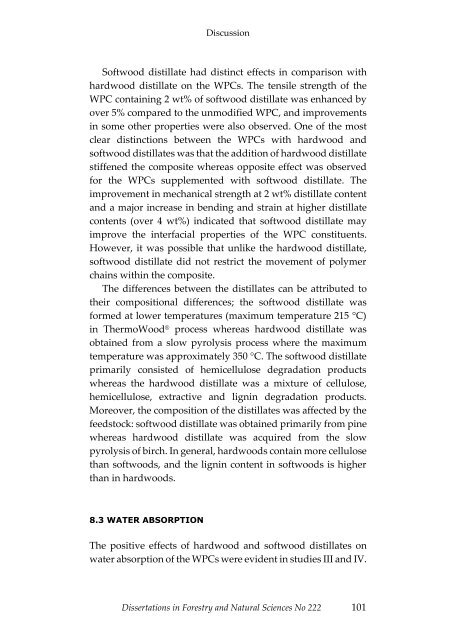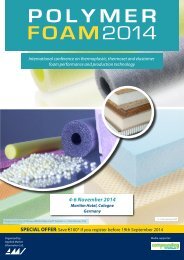Dissertations in Forestry and Natural Sciences
24lYKFN
24lYKFN
You also want an ePaper? Increase the reach of your titles
YUMPU automatically turns print PDFs into web optimized ePapers that Google loves.
Discussion<br />
Softwood distillate had dist<strong>in</strong>ct effects <strong>in</strong> comparison with<br />
hardwood distillate on the WPCs. The tensile strength of the<br />
WPC conta<strong>in</strong><strong>in</strong>g 2 wt% of softwood distillate was enhanced by<br />
over 5% compared to the unmodified WPC, <strong>and</strong> improvements<br />
<strong>in</strong> some other properties were also observed. One of the most<br />
clear dist<strong>in</strong>ctions between the WPCs with hardwood <strong>and</strong><br />
softwood distillates was that the addition of hardwood distillate<br />
stiffened the composite whereas opposite effect was observed<br />
for the WPCs supplemented with softwood distillate. The<br />
improvement <strong>in</strong> mechanical strength at 2 wt% distillate content<br />
<strong>and</strong> a major <strong>in</strong>crease <strong>in</strong> bend<strong>in</strong>g <strong>and</strong> stra<strong>in</strong> at higher distillate<br />
contents (over 4 wt%) <strong>in</strong>dicated that softwood distillate may<br />
improve the <strong>in</strong>terfacial properties of the WPC constituents.<br />
However, it was possible that unlike the hardwood distillate,<br />
softwood distillate did not restrict the movement of polymer<br />
cha<strong>in</strong>s with<strong>in</strong> the composite.<br />
The differences between the distillates can be attributed to<br />
their compositional differences; the softwood distillate was<br />
formed at lower temperatures (maximum temperature 215 °C)<br />
<strong>in</strong> ThermoWood ® process whereas hardwood distillate was<br />
obta<strong>in</strong>ed from a slow pyrolysis process where the maximum<br />
temperature was approximately 350 °C. The softwood distillate<br />
primarily consisted of hemicellulose degradation products<br />
whereas the hardwood distillate was a mixture of cellulose,<br />
hemicellulose, extractive <strong>and</strong> lign<strong>in</strong> degradation products.<br />
Moreover, the composition of the distillates was affected by the<br />
feedstock: softwood distillate was obta<strong>in</strong>ed primarily from p<strong>in</strong>e<br />
whereas hardwood distillate was acquired from the slow<br />
pyrolysis of birch. In general, hardwoods conta<strong>in</strong> more cellulose<br />
than softwoods, <strong>and</strong> the lign<strong>in</strong> content <strong>in</strong> softwoods is higher<br />
than <strong>in</strong> hardwoods.<br />
8.3 WATER ABSORPTION<br />
The positive effects of hardwood <strong>and</strong> softwood distillates on<br />
water absorption of the WPCs were evident <strong>in</strong> studies III <strong>and</strong> IV.<br />
<strong>Dissertations</strong> <strong>in</strong> <strong>Forestry</strong> <strong>and</strong> <strong>Natural</strong> <strong>Sciences</strong> No 222 101



